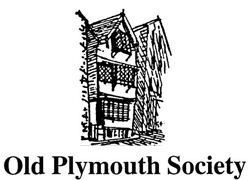by Gloria Dixon
Published March 2012
Drake’s Island lies in Plymouth Sound, covers 6.5 acres, is 916 ft above sea level and about 250 yards wide at its broadest part. It is separated from the mainland on one side by a deep channel through which warships pass to the dockyard and on the other side by a shallow channel navigable only by small craft and traversed by a ridge of underwater rocks known as The Bridge.
1135 First appears in records as St Michael’s Island, as there was a chapel dedicated to St Michael there. It passed from the Valletort family to the Priory at Plympton. The ancient deed states “cum cuniculus” which means “with rabbits”. It is assumed a beacon was serviced by the monks here, too, as the only form of lighthouses in those days were maintained by monastic orders.
Between 1135 and 1549 the chapel was re dedicated to St Nicholas, the patron saint of sailors. During the reign of Richard 2, other buildings sprang up on the steep slopes. These were Customs Houses, the equivalent of bonded stores, erected by order of the King who had given a grant of Customs to the town, since: ” merchants and seamen, native and foreign, coming to and touching a place called Conveys or Conners on the island of St Nicholas shall not pay any dues on their merchandise unless it is exposed for sale”. The main goods dealt with were iron, timber, pitch, salt, canvas, hemp and fish.
1549 Indenture made between King Edward V1 and the Mayor of Plymouth for the upkeep of a fort on the island. Chapel was demolished and first bulwark was constructed .
1551 Privy Council in London paid £79. 1s 8d to Plymouth as wages for 4 gunners, 1 at 8d per day, the rest at 6d who had lived at the fort for 2 years.
1583 Petition raised for Sir Francis Drake to be made Governor of the island. Plymouth passed ownership of the island to the state.
1599 Governorship passed to Ferdinando Gorges who held the post until 1627.
1640s During the Civil War, Plymouth declared for the Parliamentarians. Sir Alexander Carew was Governor. Carew was suspected of treason as he had been in secret communication with Royalists on the mainland. When he refused to collect his pay from the mainland, as he suspected he had been found out, he was arrested and later beheaded in London. Henry Hatsell, a respected Parliamentarian soldier, was installed as next Governor he strengthened the garrison and fortifications.
1661 The island was used as a state prison for 25 years. Some prominent people were held there, including the Reverend George Hughes, vicar of St Andrew’s Church and Abraham Cheare, a Baptist minister, who died there. Major General Lambert, Civil War leader and conspirator of Charles 2 was held for 14 years until his death in 1684.
1691 The Royal Naval Dockyard move from Cattewater to the Hamoaze had an impact on the island. Its strategic position at the mouth of the Tamar made it more important. Many proposals were made to improve its military status.
1717 Colonel Christian Lilley reported that the defences were in a terrible state and were not capable of withstanding an attack. It would cost £7000 to put it right.
1760 Battleship Conqueror was dashed to pieces here.
1763 Reported to have 23 x 32 pound guns, 6 x18 pounders and 2x13inch brass mortars. Contemporary prints of the period show a castellated building at the island’s summit and curtain walls and earthworks around its perimeter.
1771 Royal Regiment of Artillery took over manning coastal defences including the island.
1860s Larger guns were installed to be able to cope with the iron clad ships should they attack.
1897 October 11. Alice Maud Lamb was born on the island to the wife of a gunner with the Royal Artillery. She later became known as Miss Geraldine Lamb.
1899 Towards the end of the 19 century, Drake’s Island was linked by a telegraph cable to Mount Batten. March 28 records the training brig “Pilot” fouled the cable with her anchor and the local tug “Belle” was engaged to hold onto the brig while the anchor was raised and the cable cleared.
1914-18 At the beginning of the war 4 officers, 11 sergeants, 2 trumpeters and 134 men were stationed here, by 1918 this had increased to 20 officers, 5 warrant officers, 4 sergeants, 2 trumpeters
1939-41 A 40 mm anti-aircraft gun was installed, the pier was built and the slipway strengthened. An ammunition hoist was built and a tall gunnery control post was erected on the summit. Some concrete bunkers were constructed as well as the installation of a minefield control post, which, had there been an invasion would have detonated mines placed all over the Sound. There were 490 troops stationed here.
1945 For one week only in September, access to the general public was allowed. Hundreds of Plymouthians visited the island.
1956 War Department announced the island was no longer needed for defence purposes and removed all the remaining guns.
1963 War Department finally left the island and an Adventure Centre began. A covenant prohibited any commercial development on the island.
1965 Between Western Kings and the island at a depth of 108 feet, a 3000 foot long deltathene pipe was laid to bring fresh water to the island. Previously water was ferried across to the island.
1974 Custody passed from the Drake’s Island Adventure Centre to the Mayflower Centre Trust, which is responsible for running the Mayflower Centre in Central Park.
1976 Sold to the Council and the remaining buildings became Scheduled Ancient Monuments.
1987 Telephone installed on 1 May. The number was 63393.
1989 Ownership reverted to the Crown as Mayflower Trust surrendered their lease.
1995 Island sold to Dan McCauley for a reported sum of £384,000.
Nothing has happened to it since!!
